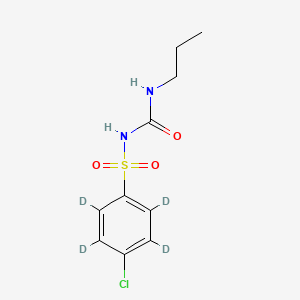
Chlorpropamide-d4
Katalognummer B586757
Molekulargewicht: 280.759
InChI-Schlüssel: RKWGIWYCVPQPMF-LNFUJOGGSA-N
Achtung: Nur für Forschungszwecke. Nicht für den menschlichen oder tierärztlichen Gebrauch.
Patent
US04062889
Procedure details


n-Propylamine (5.9 g., 0.1 mole.) and propylene carbonate (10.2 g., 0.1 mole.) were mixed and heated at 60° over night. To the resulting hydroxypropyl-n-propylcarbomate were added p-chlorobenzene sulfonamide (10.67 g., as sodium salt) and DMF (200 ml.) and the mixture was heated at 120° for 4 hours. After evaporation of the solvent the residue was taken up in water (200 ml.) and the solution adjusted to pH 8 by the addition of acetic acid. Unreacted p-chlorobenzene sulfonamide (2 g.) separated out and was collected. Further adjustment to pH 5 precipitated 1-(4-chloro-benzenesulfonyl)-3-n-propyl-urea (2 g.) whose infrared spectrum was identical with that of an authentic sample.


[Compound]
Name
hydroxypropyl-n-propylcarbomate
Quantity
0 (± 1) mol
Type
reactant
Reaction Step Two



Identifiers


|
REACTION_CXSMILES
|
[CH2:1]([NH2:4])[CH2:2][CH3:3].[C:5]1(=O)OC(C)C[O:6]1.[CH:12]1[C:17]([S:18]([NH2:21])(=[O:20])=[O:19])=[CH:16][CH:15]=[C:14]([Cl:22])[CH:13]=1>CN(C=O)C>[Cl:22][C:14]1[CH:13]=[CH:12][C:17]([S:18]([NH:21][C:5]([NH:4][CH2:1][CH2:2][CH3:3])=[O:6])(=[O:20])=[O:19])=[CH:16][CH:15]=1
|
Inputs


Step One
|
Name
|
|
|
Quantity
|
5.9 g
|
|
Type
|
reactant
|
|
Smiles
|
C(CC)N
|
|
Name
|
|
|
Quantity
|
10.2 g
|
|
Type
|
reactant
|
|
Smiles
|
C1(OCC(C)O1)=O
|
Step Two
[Compound]
|
Name
|
hydroxypropyl-n-propylcarbomate
|
|
Quantity
|
0 (± 1) mol
|
|
Type
|
reactant
|
|
Smiles
|
|
|
Name
|
|
|
Quantity
|
10.67 g
|
|
Type
|
reactant
|
|
Smiles
|
C1=CC(=CC=C1S(=O)(=O)N)Cl
|
|
Name
|
|
|
Quantity
|
200 mL
|
|
Type
|
solvent
|
|
Smiles
|
CN(C)C=O
|
Conditions


Other
|
Conditions are dynamic
|
1
|
|
Details
|
See reaction.notes.procedure_details.
|
Workups


TEMPERATURE
|
Type
|
TEMPERATURE
|
|
Details
|
heated at 60° over night
|
TEMPERATURE
|
Type
|
TEMPERATURE
|
|
Details
|
the mixture was heated at 120° for 4 hours
|
|
Duration
|
4 h
|
CUSTOM
|
Type
|
CUSTOM
|
|
Details
|
After evaporation of the solvent the residue
|
ADDITION
|
Type
|
ADDITION
|
|
Details
|
the solution adjusted to pH 8 by the addition of acetic acid
|
CUSTOM
|
Type
|
CUSTOM
|
|
Details
|
Unreacted p-chlorobenzene sulfonamide (2 g.) separated out
|
CUSTOM
|
Type
|
CUSTOM
|
|
Details
|
was collected
|
CUSTOM
|
Type
|
CUSTOM
|
|
Details
|
Further adjustment to pH 5 precipitated 1-(4-chloro-benzenesulfonyl)-3-n-propyl-urea (2 g.) whose
|
Outcomes


Product
|
Name
|
|
|
Type
|
|
|
Smiles
|
ClC1=CC=C(C=C1)S(=O)(=O)NC(=O)NCCC
|
Source


|
Source
|
Open Reaction Database (ORD) |
|
Description
|
The Open Reaction Database (ORD) is an open-access schema and infrastructure for structuring and sharing organic reaction data, including a centralized data repository. The ORD schema supports conventional and emerging technologies, from benchtop reactions to automated high-throughput experiments and flow chemistry. Our vision is that a consistent data representation and infrastructure to support data sharing will enable downstream applications that will greatly improve the state of the art with respect to computer-aided synthesis planning, reaction prediction, and other predictive chemistry tasks. |
Patent
US04062889
Procedure details


n-Propylamine (5.9 g., 0.1 mole.) and propylene carbonate (10.2 g., 0.1 mole.) were mixed and heated at 60° over night. To the resulting hydroxypropyl-n-propylcarbomate were added p-chlorobenzene sulfonamide (10.67 g., as sodium salt) and DMF (200 ml.) and the mixture was heated at 120° for 4 hours. After evaporation of the solvent the residue was taken up in water (200 ml.) and the solution adjusted to pH 8 by the addition of acetic acid. Unreacted p-chlorobenzene sulfonamide (2 g.) separated out and was collected. Further adjustment to pH 5 precipitated 1-(4-chloro-benzenesulfonyl)-3-n-propyl-urea (2 g.) whose infrared spectrum was identical with that of an authentic sample.


[Compound]
Name
hydroxypropyl-n-propylcarbomate
Quantity
0 (± 1) mol
Type
reactant
Reaction Step Two



Identifiers


|
REACTION_CXSMILES
|
[CH2:1]([NH2:4])[CH2:2][CH3:3].[C:5]1(=O)OC(C)C[O:6]1.[CH:12]1[C:17]([S:18]([NH2:21])(=[O:20])=[O:19])=[CH:16][CH:15]=[C:14]([Cl:22])[CH:13]=1>CN(C=O)C>[Cl:22][C:14]1[CH:13]=[CH:12][C:17]([S:18]([NH:21][C:5]([NH:4][CH2:1][CH2:2][CH3:3])=[O:6])(=[O:20])=[O:19])=[CH:16][CH:15]=1
|
Inputs


Step One
|
Name
|
|
|
Quantity
|
5.9 g
|
|
Type
|
reactant
|
|
Smiles
|
C(CC)N
|
|
Name
|
|
|
Quantity
|
10.2 g
|
|
Type
|
reactant
|
|
Smiles
|
C1(OCC(C)O1)=O
|
Step Two
[Compound]
|
Name
|
hydroxypropyl-n-propylcarbomate
|
|
Quantity
|
0 (± 1) mol
|
|
Type
|
reactant
|
|
Smiles
|
|
|
Name
|
|
|
Quantity
|
10.67 g
|
|
Type
|
reactant
|
|
Smiles
|
C1=CC(=CC=C1S(=O)(=O)N)Cl
|
|
Name
|
|
|
Quantity
|
200 mL
|
|
Type
|
solvent
|
|
Smiles
|
CN(C)C=O
|
Conditions


Other
|
Conditions are dynamic
|
1
|
|
Details
|
See reaction.notes.procedure_details.
|
Workups


TEMPERATURE
|
Type
|
TEMPERATURE
|
|
Details
|
heated at 60° over night
|
TEMPERATURE
|
Type
|
TEMPERATURE
|
|
Details
|
the mixture was heated at 120° for 4 hours
|
|
Duration
|
4 h
|
CUSTOM
|
Type
|
CUSTOM
|
|
Details
|
After evaporation of the solvent the residue
|
ADDITION
|
Type
|
ADDITION
|
|
Details
|
the solution adjusted to pH 8 by the addition of acetic acid
|
CUSTOM
|
Type
|
CUSTOM
|
|
Details
|
Unreacted p-chlorobenzene sulfonamide (2 g.) separated out
|
CUSTOM
|
Type
|
CUSTOM
|
|
Details
|
was collected
|
CUSTOM
|
Type
|
CUSTOM
|
|
Details
|
Further adjustment to pH 5 precipitated 1-(4-chloro-benzenesulfonyl)-3-n-propyl-urea (2 g.) whose
|
Outcomes


Product
|
Name
|
|
|
Type
|
|
|
Smiles
|
ClC1=CC=C(C=C1)S(=O)(=O)NC(=O)NCCC
|
Source


|
Source
|
Open Reaction Database (ORD) |
|
Description
|
The Open Reaction Database (ORD) is an open-access schema and infrastructure for structuring and sharing organic reaction data, including a centralized data repository. The ORD schema supports conventional and emerging technologies, from benchtop reactions to automated high-throughput experiments and flow chemistry. Our vision is that a consistent data representation and infrastructure to support data sharing will enable downstream applications that will greatly improve the state of the art with respect to computer-aided synthesis planning, reaction prediction, and other predictive chemistry tasks. |
